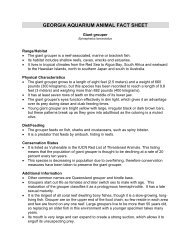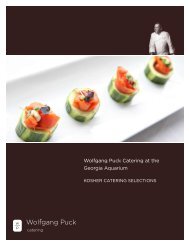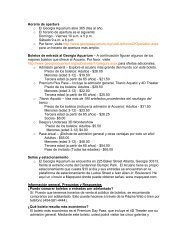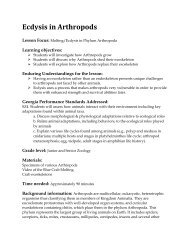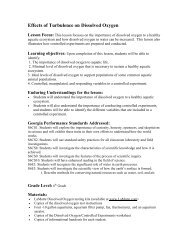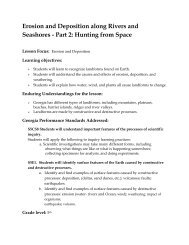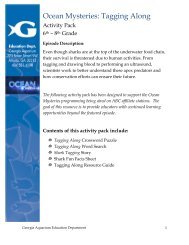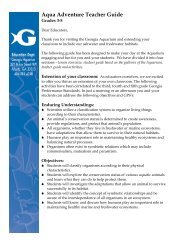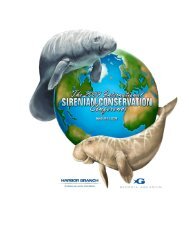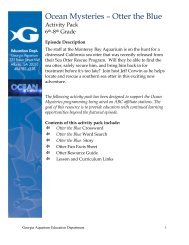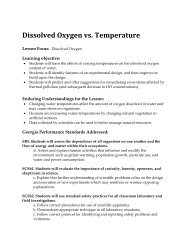You also want an ePaper? Increase the reach of your titles
YUMPU automatically turns print PDFs into web optimized ePapers that Google loves.
<strong>Aqua</strong> <strong>Tales</strong><br />
Teachers Guide<br />
Pre-K<br />
Program Description: Join Deepo, the aquarium’s mascot, on a<br />
wonderful storybook adventure! Students will learn how animals move and<br />
survive in their homes. Throughout the interactive program, students will<br />
discover the unique characteristics of our aquarium friends!<br />
Enduring Understandings for <strong>Aqua</strong> <strong>Tales</strong>:<br />
Animals have different shapes, colors and sizes that help them live in<br />
their unique habitats.<br />
Through observations we can learn about aquatic animals, their<br />
habitats, and their unique movements.<br />
Objectives:<br />
Students will identify similarities and differences in animals to group<br />
living things.<br />
Students will understand that the movement of animals is important to<br />
their survival.<br />
Students will understand that animals do not look the same through all<br />
stages of their life cycles.<br />
<strong>Georgia</strong> Performance Indicators Addressed:<br />
Language & Literacy Development<br />
LD 1: Children will develop skills in listening for the purpose of<br />
comprehension<br />
a. Listens to and follows spoken directions<br />
b. Responds to questions<br />
d. Listens to stories read aloud and shows understanding through<br />
body language or by interacting appropriately<br />
LD 4: Children will develop and expand expressive language skills (speaking)<br />
b. Engages in conversations with adults and children<br />
c. Uses language to pretend or create<br />
LD 5: Children will begin to develop age-appropriate strategies that will assist<br />
in reading<br />
b. Discusses books or stories read aloud<br />
Mathematical Development<br />
MD 1: Children will begin to develop understanding of numbers<br />
c. Counts objects using one-to-one correspondence
d. Compares sets of objects using language<br />
g. Associates numeral name with set of objects<br />
MD 2: Children will create and duplicate simple patterns<br />
a. Copies a pattern using sounds or physical movements<br />
MD 4: Children will develop a sense of space and an understanding of basic geometric<br />
shapes.<br />
c. Uses language to indicate where things are in space: positions, directions,<br />
distances, order<br />
Scientific Development<br />
SD 1: Children will use processes of science to actively explore and increase<br />
understanding of the environment<br />
b. Uses senses to observe, classify, and learn about objects<br />
c. Uses language to describe observation<br />
SD 2: Children will acquire scientific knowledge related to life science<br />
a. Observes, explores, and describes a wide variety of animals and plants<br />
SD 3: Children will acquire scientific knowledge related to physical science<br />
b. Describes objects by their physical properties<br />
d. Investigates different types/speeds of motion<br />
Pre-visit activities:<br />
1. <strong>Aqua</strong>rium Animal Flash Cards<br />
2. Deepo Garibaldi Fish Name Tags<br />
Post-visit activities:<br />
1. Deepo Placemat<br />
2. Read an aquatic story and discuss with class. Our recommendations:<br />
My Visit to the <strong>Aqua</strong>rium: Aliki ISBN #0064461866<br />
Baby Beluga: Raffi Cavoukian ISBN #0517583623<br />
Five Little Sharks Swimming in the Sea: Steve Metzger ISBN #0439737672<br />
Don’t Eat the Teacher!: Nick Ward ISBN #1407105981<br />
Turtle Splash: Catheryn Falwell ISBN # 0061429279<br />
Deepo Name Tags (Pre-visit activity)
Objective: Students will learn the difference between young and adult Garibaldi fish<br />
and will make name tags for their visit to the <strong>Georgia</strong> <strong>Aqua</strong>rium.<br />
Duration: 15-20 minutes<br />
Materials:<br />
Deepo name tag cut-outs (one for each child)<br />
Blue and orange crayons or markers<br />
Hole punch<br />
Yarn or string (cut into lengths for necklaces)<br />
Procedure:<br />
1. Ask the students if animals always look the same as their parents and give some<br />
examples (e.g. tadpoles become frogs and caterpillars become butterflies)<br />
2. Show the group a picture of Deepo, the <strong>Georgia</strong> <strong>Aqua</strong>rium’s mascot. Deepo is<br />
an adult Garibaldi fish, but when he was young he looked very different.<br />
3. Show the group Deepo’s baby picture. Young Garibaldi fish are covered in blue<br />
spots!<br />
4. Explain to the students that they are going to be a school of young Garibaldi fish<br />
for the day when they go to the aquarium to meet Deepo.<br />
5. Pass out the name tags to the students and let them color in Deepo and his blue<br />
spots.<br />
6. For sturdier name tags, you can laminate them, glue them onto posterboard, or<br />
print the tags out on cardstock.<br />
7. Write the students’ names on their tags, hole-punch each one and string it on a<br />
piece of yarn.<br />
8. Have the students wear their name tags on the day of their field trip.
<strong>Aqua</strong>rium Animal Flash Cards (Pre-visit activity)
Objective: Students will practice identifying aquatic animals they will encounter<br />
during their program.<br />
Duration: 15-20 minutes<br />
Materials:<br />
<strong>Aqua</strong>rium Animal Flash Cards (provided)<br />
Procedure:<br />
1. Hold up one flash card at a time and name the animal. Have the children repeat<br />
the name.<br />
2. Alternate activity: Memory Game<br />
Make a second copy of the cards and place them face down on a table.<br />
Have a child flip up one card and then another card to see if they match; if<br />
they do, that child turns over a second pair of cards.<br />
*If playing the game with more than one child, have them take turns<br />
turning over the cards.
HAMMERHEAD<br />
SHARK<br />
WHALE SHARK<br />
ALLIGATOR<br />
OCTOPUS
SEA TURTLE<br />
BELUGA WHALE<br />
SEA STAR<br />
JELLY
STINGRAY<br />
CLOWNFISH<br />
GARIBALDI FISH<br />
(DEEPO!)<br />
FROG
OTTER<br />
SEAHORSE
Deepo Placemats (Post-Visit Activity)<br />
Objective: Students will review the highlights of their trip and make a<br />
memento featuring Deepo and their favorite animals.<br />
Duration: 30 minutes<br />
Materials:<br />
Deepo picture (below)<br />
Markers or Crayons<br />
Blue and white construction<br />
paper<br />
Green tissue paper<br />
Glue stick<br />
Contact Paper or Laminate<br />
Instructions:<br />
1. Make copies of Deepo.<br />
2. Have the students color Deepo with markers or crayons.<br />
3. Glue Deepo to the center of the blue construction paper.<br />
4. Tear the tissue paper into strips and glue on the blue construction<br />
paper.<br />
5. Ask your students what their favorite animal was that they saw at the<br />
aquarium. Why<br />
6. Have the students draw their favorite aquarium animal and its<br />
habitat on the white construction paper.<br />
7. Glue the back of the blue paper to the back of the white paper.<br />
8. Cover both sides of the construction paper with contact paper or<br />
laminate.<br />
9. Discuss their favorite animals. Was the animal big or small What<br />
color was it<br />
10. Ask the students how their animals move, and have them move like<br />
that animal.



